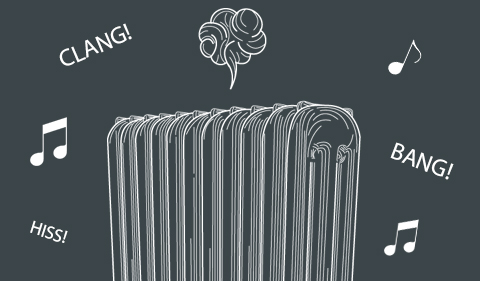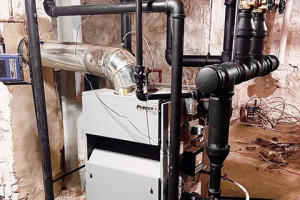
Hello, old friend. I’m writing today to say thanks, and to say farewell. This will be my last column.

In 1992, I self-published a thick book I called, "The Lost Art of Steam Heating." I did this because I could not get a publisher interested in something that few, if any, contractors had installed since the 1930s. I thought it would do well in New York City, where there are still plenty of steam-heated buildings, but to my delight, we sold tens of thousands of copies everywhere, and even in Hawaii. Go figure.
A chapter in that book dealt with the causes of water hammer, which will plague any system that suffers from neglect. Water hammer happens when water hangs around inside the pipes long after the other party guests, those being air and steam, have left. The water lies in the horizontal pipes because of poor pitch, and the next time the steam arrives, moving at about 60 mph, it rams the water down the pipe like an artillery shell. The water, which for our purposes is not compressible, hits the first turn in the pipe with a wallop that sounds like someone is hitting an anvil with a sledge hammer. Hence, the anvil chorus, but minus Giuseppe Verdi’s operatic talents.
Some years after "Lost Art", came out, another, less-famous composer, wrote to me and said he would like to write a symphony based on the sounds of water hammer in steam pipes.
“Seriously?” I said.
“Yes, I find the sounds to be so interesting,” Travis Ramsey, the young composer said.
“Is that all it’s going to be? Water hammer noise?”
“Oh, no,” he said. “There will be many instruments. The water hammer will just be a part of it all. It’s going to be beautiful.”
“You think water hammer is beautiful?”
“I think it’s musical. Like chimes.”
“Those are some muscular chimes,” I said. “But to each his own. How can I help?”
“I’d love to be able to call the piece The Lost Art of Steam Heating. Would that be okay with you?”
“Do steam air vents whistle?” I said.
“Huh?”
“Yes, of course, it’s okay with me,” I sputtered. “I’m honored.”
So Travis Ramsey went ahead and wrote that symphony and led an orchestra on opening night. He sent me a copy of the performance on CD. (You can listen to it here.) It was lovely and sort of New-Agey, and the pipes, the pipes were certainly calling. And this proves, once again, that one man’s ceiling is another man’s floor. There is beauty everywhere if you just take the time to see it. Or in this case, hear it. Water hammer as music. Imagine that.
Another time, I read a thread on The Wall at HeatingHelp.com that caught my attention because the title of that thread read, "Stop steam vent whistling." The person who started the thread used the nickname Precaud, which doesn’t mean anything as far as I know. It also doesn’t tell me anything about the poster. But what he or she posted sure did.
“I, for one, am not bothered by steam air vents making noise,” s/he wrote. “I kinda like keeping in touch with what my steam system is doing via the noises it makes. And since venting the steam main, I rarely hear anything from the radiator vents, except air being drawn in through open vents at the end of a cycle.”
Okay, let’s pause here. I’m guessing Precaud is working on his or her own steam system and not a customer’s. S/He understands the importance of main vents, and that steam will condense, form a partial vacuum within the pipes, which air will fill by moving backward through the air vents.
“Once or twice during the first cycle of recovery from a setback,” Precaud writes, “I have heard a faint whistle from the air vent on the last radiator in the chain. It happened after the main vent closed and steam started filling the radiator. It’s nothing objectionable.”
I think Precaud is definitely a homeowner. It would be unusual for a steam pro to be hanging around during recovery after a setback. That’s most likely going to happen while the homeowner is still in bed. So a homeowner, not a pro. But what a homeowner! Here, read more:
“But for those that are bothered by it, there's an easy fix. Acoustically speaking, steam air vents are like miniature flutes. With sufficient air velocity, they will resonate at three frequencies and their harmonics will relate to the length of the orifice cylinder, the circumference of the vent orifice, and the circumference of the surface around that orifice. The orifice dimensions are the dominant components. The smaller the hole, the higher the pitch, and the less audible it will be. Well, at least for humans; your dog or cat may have a different opinion. If any of those three dimensions are close to being integer multiples of each other, their resonance and harmonics will combine, be much louder, and have a more distinctive pitch.”
Are you following all of this? What do you think this person does for a living? Audiologist? Musician? Opera singer? Perhaps an engineer who spends most of the day looking at his or her own shoes while speaking? I don’t know either, but during the more than 50 years I’ve been poking around steam systems, this was the first time I ever heard anyone talk about hissing vents as musical instruments. And flutes no less! Gosh.
“The easy solution,” s/he continued, “is to chamfer the hole. This shortens the cylinder and makes the transition from the orifice into free air happen gradually and over a range of frequencies. I’ve done this to a vent by enlarging the hole with a 5/64" drill bit, which makes it a "#5.5" on the air-venting scale of this particular vent. It’s right in between a #5 and a #6. I then countersunk the flat top with a 7/16" drill bit. This small countersink is sufficient to turn a whistle into a low hiss.”
Fred, one of the pros who posts regularly on The Wall forum, answered this by posting, “The better solution might be to keep the system pressure down, below 1-psi or so. That will keep the air velocity low enough to avoid whistling or hissing. That may mean resetting and/or calibrating the Pressuretrol and making sure the pigtail is clean and open so that the Pressuretrol can see the system pressure and manage it.”
That’s what I would do, but now I’m feeling like I really don’t understand the science of harmonics at all. And I don’t think I’ve ever used the word chamfer in a sentence until I typed Precaud’s quote above.
To answer Fred, he wrote, “Not really. My system shows no measurable pressure at any point in the cycle.”
So there.
I would love to put Precaud together with Travis Ramsey. Can you imagine what those two could do with an orchestra pit filled with banging pipes and hissing (or resonating) air vents? Put together an audience of several thousand screaming tenants, frustrated landlords and knuckleheaded building superintendents who know nothing other than how to raise the steam pressure, and you’re just about ready for Carnegie Hall.
Bravo!

Hello, old friend. I’m writing today to say thanks, and to say farewell. This will be my last column.

My six-year-old grandboy, Brendan, was in the vestibule of the diner when the bubblegum machine caught his attention. It was one of those spiral models that appeared in t...

Subdural posed a question on The Wall at HeatingHelp.com in the Strictly Steam section, where some of the sharpest knives in the drawer post every day. The question was a...